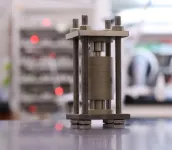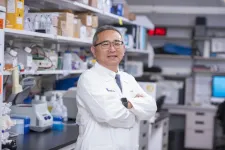(Press-News.org) ANN ARBOR, Michigan -- It was an unexpected discovery that started with an analysis of more than 1,000 genes. The question: why game-changing cancer immunotherapy treatments work for only a fraction of patients.
The analysis shone a light on one that popped up repeatedly in patients and mouse models that did not respond to immune checkpoint therapy: stanniocalcin-1, a glycoprotein whose role in both tumors and immunology is largely unknown.
By following the trail from this surprising thread, a University of Michigan Rogel Cancer team uncovered how stanniocalcin-1, or STC1, works inside the cell to block a cellular "eat-me" signal that typically triggers the immune system to produce T cells to fight the tumor. The findings, published in Cancer Cell, provide a potential target to improve immune responses to cancer.
"We believe STC1 is a checkpoint inside the cell. It's an eat-me blocker - it blocks macrophages and dendritic cells to eat dying or dead cancer cells. We think that if we can target the STC1 pathway, it would release the blocked eat-me signal," says study senior author Weiping Zou, M.D., Ph.D., Charles B. de Nancrede Professor of Pathology, Immunology, Biology, and Surgery at the University of Michigan.
Zou and colleagues were drawn to STC1 in part because so little was known about its role in cancer. This provided a potentially interesting opportunity, but also some difficulty as they had to start at the very beginning to understand whether STC1 was causing the poor immune response or whether it was just a bystander.
They embarked on a lengthy process, first showing that STC1 was linked with low activation of T cells and worse survival in melanoma patients treated with immunotherapy. They checked against the Cancer Genome Atlas database and found high levels of STC1 tied to worse survival in 10 different cancer types. The finding also panned out in mouse models.
From there, the researchers used mouse models to show that STC1 within tumors was dampening the anti-tumor T cell response by impairing the antigen presenting cells, which are essential for triggering T cells. They showed that tumor STC1 was stopping the process of macrophages, a type of antigen presenting cell, from eating dying tumor cells - a process key to presenting antigen to T cells and activating them.
Specifically, the tumor STC1 traps a key eat-me signal called calreticulin, or CRT. Without sufficient surface CRT, the macrophages won't efficiently eat the dead tumor cells. Unblock the CRT and it unblocks this process. This suggests that targeting the interaction between STC1 and CRT might be a path toward making immunotherapy more effective.
It's an unusual mechanism. Most immune checkpoint therapies are based on direct surface interactions with T cells.
"What we are talking about is before anything has happened. Before the T cells were activated, the tumors have already implemented strategies so they cannot be captured. This may be why some patients are resistant to immunotherapy: their tumors express too much STC1. When you block the eat-me signal, the antigen presenting cells cannot do their job," Zou says.
Targeting the STC1 and CRT interaction inside the cell is trickier than if it were on the cell surface. It means a typical antibody approach will not work. Instead, Zou and colleagues are investigating whether they can develop a small compound that would penetrate the cell and interfere with the STC1-CRT interaction.
INFORMATION:
Additional authors: Heng Lin, Ilona Kryczek, Shasha Li, Michael D. Green, Alicia Ali, Reema Hamasha, Shuang Wei, Linda Vatan, Wojciech Szeliga, Sara Grove, Xiong Li, Jing Li, Weichao Wang, Yijan Yan, Jae Eun Choi, Gaopeng Li, Yingjie Bian, Ying Xu, Jiajia Zhou, Jiali Yu, Houjun Xia, Weimin Wang, Ajjai Alva, Arul M. Chinnaiyan, Marcin Cieslik
Funding: National Cancer Institute grants CA248430, CA217648, CA123088, CA099985, CA193136, CA152470, P30CA46592
Disclosure: None
Reference: Cancer Cell, doi: 10.1016/j.ccell.2020.12.023
Resources:
University of Michigan Rogel Cancer Center, http://www.rogelcancercenter.org
Michigan Health Lab, http://www.MichiganHealthLab.org
Michigan Medicine Cancer AnswerLine, 800-865-1125
Scientists at the National Eye Institute (NEI) have developed a promising gene therapy strategy for a rare disease that causes severe vision loss in childhood. A form of Leber congenital amaurosis, the disease is caused by autosomal-dominant mutations in the CRX gene, which are challenging to treat with gene therapy. The scientists tested their approach using lab-made retinal tissues built from patient cells, called retinal organoids. This approach, which involved adding copies of the normal gene under its native control mechanism, partially restored CRX function. The study report appears today in Stem ...
In early October 2019, when an unknown caller rang EPFL professor Johan Gaume's cell phone, he could hardly have imagined that he was about to confront one of the greatest mysteries in Soviet history. At the other end of the line, a journalist from The New York Times asked for his expert insight into a tragedy that had occurred 60 years earlier in Russia's northern Ural Mountains - one that has since come to be known as the Dyatlov Pass Incident. Gaume, head of EPFL's Snow and Avalanche Simulation Laboratory (SLAB) and visiting fellow at the WSL Institute for Snow and Avalanche Research SLF, had never heard ...
Researchers at the University of Basel and Ruhr University Bochum have developed a source of single photons that can produce billions of these quantum particles per second. With its record-breaking efficiency, the photon source represents a new and powerful building-block for quantum technologies.
Quantum cryptography promises absolutely secure communications. A key component here are strings of single photons. Information can be stored in the quantum states of these light particles and transmitted over long distances. In the future, remote quantum processors will communicate with each other via single photons. And perhaps the processor itself will use photons as quantum bits for computing.
A basic prerequisite for such applications, however, is an efficient source ...
Using X-ray tomography, a research team has observed the internal evolution of the materials inside solid-state lithium batteries as they were charged and discharged. Detailed three-dimensional information from the research could help improve the reliability and performance of the batteries, which use solid materials to replace the flammable liquid electrolytes in existing lithium-ion batteries.
The operando synchrotron X-ray computed microtomography imaging revealed how the dynamic changes of electrode materials at lithium/solid-electrolyte interfaces determine the behavior of solid-state batteries. The researchers found that battery operation caused voids to form ...
Science is society's best method for understanding the world, yet many people in the field are unhappy with the way it works. Rules and procedures meant to promote innovative research can have perverse side-effects that harm both science and scientists. One of these - the 'priority rule' - rewards scientists who make discoveries with prestige, prizes and better career opportunities, depriving the runners-up of similar perks. Researchers at University of Technology Eindhoven (TU/e) and the Arizona State University in the US have developed a new model to better understand this rule, and see if current reforms to improve the system actually make sense. Their study was published in Nature Human Behaviour.
"Over the past decade, there have been growing concerns that something ...
What The Study Did: This study finds that being a health care worker isn't associated with poorer outcomes among patients hospitalized with COVID-19.
Authors: Nauzer Forbes, M.D., M.Sc., of the University of Calgary in Canada, is the corresponding author.
To access the embargoed study: Visit our For The Media website at this link https://media.jamanetwork.com/
(doi:10.1001/jamanetworkopen.2020.35699)
Editor's Note: The article includes conflict of interest disclosures. Please see the article for additional information, ...
Risky behaviors such as smoking, alcohol and drug use, speeding, or frequently changing sexual partners result in enormous health and economic consequences and lead to associated costs of an estimated 600 billion dollars a year in the US alone. In order to define measures that could reduce these costs, a better understanding of the basis and mechanisms of risk-taking is needed.
Functional and anatomical differences
UZH neuro-economists Goekhan Aydogan, Todd Hare and Christian Ruff, together with an international research team looked at the genetic characteristics that correlate with risk-taking behavior. Using a representative sample of 25,000 people, the researchers examined the relationship ...
BOSTON - A nationwide panel of experts has developed the first mammography guidelines for older survivors of breast cancer, providing a framework for discussions between survivors and their physicians on the pros and cons of screening in survivors' later years.
The guidelines, published online today in a paper in JAMA Oncology, recommend discontinuing routine mammograms for survivors with a life expectancy under five years; considering stopping screening for those with a 5-10-year life expectancy; and continuing mammography for those whose life expectancy is greater than 10 years. The guidelines will be complemented by printed materials to help survivors gauge their risk of cancer recurring in the breast and weigh the potential benefits and drawbacks of mammography with ...
Science is society's best method for understanding the world. Yet many scientists are unhappy with the way it works, and there are growing concerns that there is something "broken" in current scientific practice. Many of the rules and procedures that are meant to promote innovative research are little more than historical precedents with little reason to suppose they encourage efficient or reliable discoveries. Worse, they can have perverse side-effects that harm both science and scientists. A well-known example is the general preference for positive over negative results, which creates a "publication bias" that gives the false ...
CLEVELAND - Cleveland Clinic researchers have described for the first time how Zika virus (ZIKV) causes one of the most common birth defects associated with prenatal infection, called brain calcification, according to new study findings published in Nature Microbiology.
The findings may reveal novel strategies to prevent prenatal ZIKV brain calcification and offer important insights into how calcifications form in other congenital infections.
"Brain calcification has been linked to several developmental defects in infants, including motor disorders, cognitive disability, eye abnormalities, hearing deficits and seizures, so it's important to better understand the mechanisms of how they develop," said Jae Jung, ...







